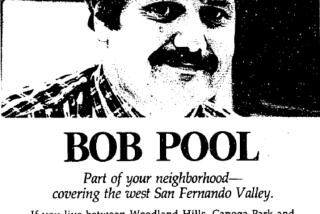A Man Too Far Ahead of His Time : The Author of the Oz Books Came to Live in California, Which Has Lead to Considerable Speculation
“Was it real or was it a dream?” The question has been raised again and again about the land of Oz. In the 1939 MGM movie “The Wizard of Oz,” Dorothy is hit on the head during the cyclone and dreams up the magical land. Nothing like that happens in L. Frank Baum’s book “The Wonderful Wizard of Oz.” Judy Garland may have wished to go somewhere over the rainbow, but in the book the cyclone takes Dorothy to Oz while she is wide awake--and quite against her wishes. In the book, Oz is a real place, not a land created by Dorothy’s fertile imagination.
Readers used to write Baum and ask just where Oz was. Some thought it somewhere near Chicago; after all, Baum wrote “The Wonderful Wizard of Oz” while living there. And, when one considers the map of Oz, it is not an altogether unreasonable proposition: To the west is the land of the Winkies, a wild, untilled region full of marauding prairie wolves, somewhat like South Dakota; to the east is the land of the Munchkins, a place that resembles the Pennsylvania Dutch country. To the south is the land of the Quadlings, inhabited in part by hillbilly-like Hammerheads. To the north, in later Oz books, is Gillikin Country, a place of mountains and lakes not unlike Michigan.
(Apparently Baum was also very impressed by the World’s Columbian Exposition held in Chicago in 1893, which, according to observers, seems to have been a very Oz-like affair, “with streets thronged with characters straight out of the Arabian Nights . . . (and) a full-size knight in armor on a full-size horse (both made out of dried California prunes). . . .”)
But consider the clues in the book. Dorothy lives on the dry Kansas prairie. She goes to Oz, the complete opposite of Kansas--a green land abundant with fruit, flowers and birds. Visionary that he was, Baum had anticipated, by more than 35 years, the Dust Bowl conditions of “The Grapes of Wrath” and the great migration to California.
Only a few people have come right out and said that Oz is California. One of these is scholar Jordan Brotman: “The Oz books (have) a kind of California extravagance about them, and I (can) remember the time when California, with its sunshine and its golden oranges and movies, was an earthly paradise hankered after by people all over the country, certainly in the Midwest.”
But Brotman is a little smug about his discovery and takes the traditional academic potshots: “In Oz, just as in idyllic California, people stop and congratulate each other about the place and the climate.”
Not only did Baum anticipate the great migration to California a generation before it occurred, but he also got here before it happened. A few years after his prescience in “The Wonderful Wizard of Oz,” he began to spend his winters on Coronado Island in San Diego. In an interview in the San Diego Tribune in 1904, he said: “Those who do not find Coronado a paradise have doubtless brought with them the same conditions that would render heaven unpleasant to them did they chance to gain admittance.”
At first, Baum took up residence in the Hotel del Coronado, where he designed the giant chandeliers for the Crown Room to look like the crowns in illustrations in his Oz books (the design would become the hotel’s logo). Later, he rented a cottage on Coronado’s Star Park Circle.
Actually living in the place of his dreams had an immediate effect on his writing; as Baum’s daughter observed, “Dorothy and the Wizard of Oz” (1908), one of the books in the Oz series, “is the first (Oz book) with a California setting. . . . Dorothy and the Wizard drop through a rift in the ground caused by a California earthquake and meet in a glass city, the abode of people who grow like vegetables.” Other books by Baum, not in the Oz series--”The Sea Fairies” (1911) and “Sky Island” (1912)--also started on the shores of the Pacific, and featured such familiar locales as the Cove in La Jolla.
In 1909, Baum moved permanently to California, and in 1910 he purchased a house in Hollywood and named it “Ozcot.” And he went about re-creating a miniature Oz there--building his home around an enormous cage of songbirds, daily writing the “history” of Oz in his garden courtyard, cultivating flowers and earning the title of Dahlia King of California.
Baum was forward-looking in another sense: He settled in Hollywood during the very beginnings of the motion-picture business, and became involved in the new and experimental form of entertainment, moving from the stage to magic-lantern presentations to one-reel films and founding his own movie company (The Oz Film Manufacturing Co.). But the public wasn’t ready for him, and his half-dozen films only brought him financial problems, even though they are said to have had special effects almost as dazzling as MGM’s “Wizard of Oz” 25 years later.
Baum also anticipated Walt Disney. In 1916 he conceived a musical version of “Snow White,” but the idea never got off the ground. Twenty-one years later, Disney released just such a musical and established the cash foundation that would enable him, among other things, to build Disneyland in Anaheim.
Even here, Baum was way ahead of his time. In 1905, Baum informed the press he planned to build a pleasure park--a miniature Oz--for children and their families on an island off the California coast. Another idea whose time had not yet come, this magic kingdom was never built.
Such was the fate of L. Frank Baum, a man too far ahead of his time. He died in 1919 and was buried in a modest grave at Forest Lawn. And some of those who would migrate to the land that Baum had made his home realized what he had realized: that California was Oz--or Oz, California.
More to Read
Sign up for our Book Club newsletter
Get the latest news, events and more from the Los Angeles Times Book Club, and help us get L.A. reading and talking.
You may occasionally receive promotional content from the Los Angeles Times.







